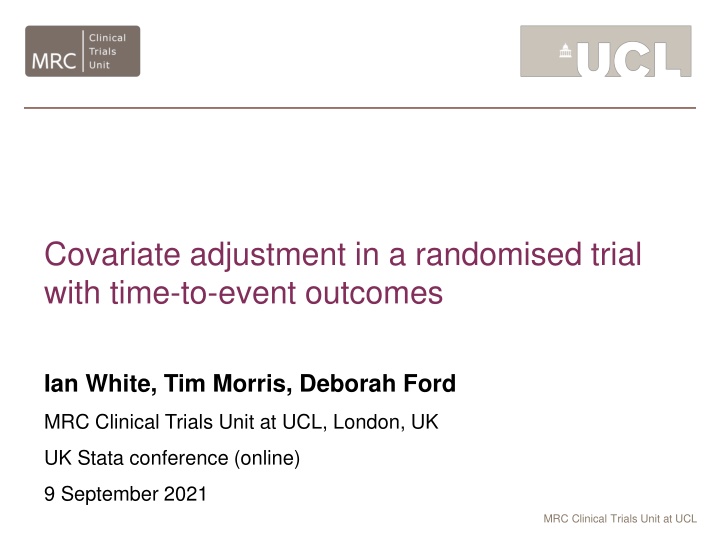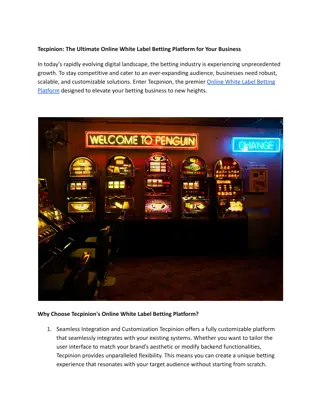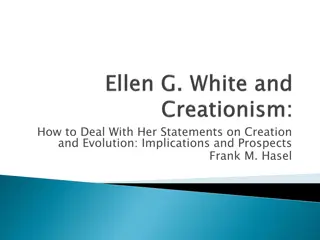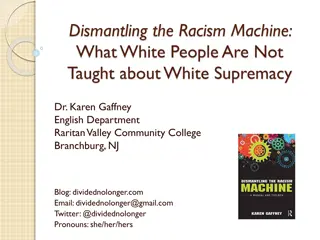
Covariate Adjustment in Randomised Trial Analysis
Learn about the challenges and methods for covariate adjustment in a randomised trial with time-to-event outcomes, as discussed in a presentation at the UK Stata conference. The study focuses on the ODYSSEY trial involving children with HIV, aiming to estimate the risk difference between treatment regimens. Explore model-based versus estimand-based approaches, non-standard estimands, and methods for covariate-adjusted estimation.
Download Presentation

Please find below an Image/Link to download the presentation.
The content on the website is provided AS IS for your information and personal use only. It may not be sold, licensed, or shared on other websites without obtaining consent from the author. If you encounter any issues during the download, it is possible that the publisher has removed the file from their server.
You are allowed to download the files provided on this website for personal or commercial use, subject to the condition that they are used lawfully. All files are the property of their respective owners.
The content on the website is provided AS IS for your information and personal use only. It may not be sold, licensed, or shared on other websites without obtaining consent from the author.
E N D
Presentation Transcript
Covariate adjustment in a randomised trial with time-to-event outcomes Ian White, Tim Morris, Deborah Ford MRC Clinical Trials Unit at UCL, London, UK UK Stata conference (online) 9 September 2021 MRC Clinical Trials Unit at UCL
Setting The ODYSSEY trial recruited 707 children infected with HIV and randomised them 1:1 to a new (safer & more convenient) treatment regimen including dolutegravir (DTG), or a standard of care regimen (SOC) The outcome was virological or clinical failure by 96 weeks actual time was recorded A number of baseline variables ( covariates ) were recorded, and three of these were predefined for use in the analysis The estimand was the difference in cumulative outcome incidence ( risk ) at 96 weeks (DTG SOC) The aim was to show that DTG is non-inferior, defined as < 0.1 2 MRC Clinical Trials Unit at UCL
Model-based vs. estimand-based approaches to statistical analysis Model-based Report model parameter Choose outcome Choose model Estimand-based Choose estimand Choose method Report estimand 3 MRC Clinical Trials Unit at UCL
Challenges here Non-standard estimand difference in risk at 96 weeks not a parameter in a model could use difference between Kaplan-Meier curves if no covariate adjustment Covariate adjustment not to control confounding to improve power to improve precision of estimation of the estimand 4 MRC Clinical Trials Unit at UCL
Methods for covariate-adjusted estimation of a chosen estimand Find a model where the estimand is a parameter Not always possible e.g. binary outcome: binreg, rd Regression adjustment Choose a model Compute estimand from model fit Broadly applicable logistic then margins Standardisation Inverse probability of treatment weighting Construct weights from covariates Use in unadjusted estimation Broadly applicable teffects ipw 5 MRC Clinical Trials Unit at UCL
Aim & plan Aim: How should we perform covariate adjustment to estimate the risk difference in the ODYSSEY trial? We need to specify this in advance in a statistical analysis plan. Plan: 1. Describe a basic approach using margins, which almost works Describe three alternatives which do work Compare results 2. 3. Paul Lambert last year, and Elisavet Syriopoulou before lunch, described covariate adjustment for time-to-event outcomes by standardisation using standsurv. This talk covers similar ground but is much less general and uses Cox, not parametric, survival models. 6 MRC Clinical Trials Unit at UCL
Notation ? randomised treatment (DTG=1, SOC=0) ? vector of covariates (7 dummies for the interaction of 3 binary factors) ? time to virological or clinical failure Risk: ? ? < 96 Estimand: = ? ?1< 96 ? ?0< 96 = ? ? < 96 ? = 1 ? ? < 96 ? = 0) Cox model: ? ?,? = 0? exp(?? + ? ?) 7 MRC Clinical Trials Unit at UCL
KMunicate graph style: Morris et al, BMJ Open 2019 Cox model result Hazard ratio, DTG vs SOC = 0.60 (0.42 to 0.86) (unaffected by covariate adjustment to 2dp) Cumulative incidence SOC .2 .1 DTG 0 0 24 48 72 96 Months DTG At risk Censored Event SOC At risk Censored Event 350 343 341 319 300 0 0 1 6 2 7 3 4 28 46 357 347 338 295 10 276 12 69 0 0 3 7 8 MRC Clinical Trials Unit at UCL 52 11
Approach 1: margins We use the margins command to estimate the marginal risks and the risk difference. Approach: Cox model ? ?,? = 0? exp(?? + ? ?) baseline survival = ?096 risk given ? = ? and ? = ? is 1 ?096exp ??+? ? margin given ? = ? is 1 ? ?1 ?096exp ??+? ?? o NB sum over all individuals (both arms ?) so adjusted marginal treatment effect (? = 1 vs 0) is 1 ? ? 1 ?096exp ?+? ?? 1 ?096exp ? ?? 9 MRC Clinical Trials Unit at UCL
dtg = ? = treatment strata = ? = covariates Stata method Fit Cox model and extract baseline survivor function and linear predictor stcox i.dtg i.strata, basesurv(S0) Find ?0(96) summ S0 if _t<=96, meanonly local S096 = r(min) Compute marginal risk by arm margins dtg, expression(1-`S096'^exp(predict(xb))) can also work on the log-log scale Compute marginal risk difference margins r.dtg, expression(1-`S096'^exp(predict(xb))) Ignores uncertainty in the baseline survivor function 10 MRC Clinical Trials Unit at UCL
Results Estimate 0.137 95% CI Estimand DTG risk Scale for CI probability log-log probability log-log probability 0.080 0.089 0.169 0.173 -0.129 0.193 0.203 0.265 0.269 -0.032 SOC risk 0.217 DTG SOC -0.080 Impact of ignoring uncertainty in the baseline survivor function? baseline = SOC arm & first stratum asymmetrical e.g. reversing coding of treatment increases SE of DTG SOC by 50% definitely bad for arm-specific risks (results later) 11 MRC Clinical Trials Unit at UCL
Approach 2: margins + bootstrap Bootstrapping the whole procedure (Cox model + margins) should correctly allow for all sources of uncertainty We compare confidence intervals produced by normal theory and by bootstrapping, and (for the risks) using the log-log transform 1000 bootstrap samples used same seed & details as in primary analysis 12 MRC Clinical Trials Unit at UCL
Results for treatment effect using margins +/- bootstrap Method margins, ignore uncertain S0 margins + bootstrap + Normal CI margins + bootstrap + percentile CI margins + bootstrap + bias-corrected CI Estimate -0.080 -0.080 -0.080 -0.080 95% CI -0.129 -0.135 -0.139 -0.142 -0.032 -0.026 -0.028 -0.031 Results reported in ODYSSEY paper Conclusion: ignoring uncertain S0 gives slightly too narrow CI Note: Monte Carlo error on confidence limits is <0.001 for normal, <0.004 for percentile & BC. Why is there no bootstrap, mcerror? 13 MRC Clinical Trials Unit at UCL
Approach 3: standsurv We compare these methods with Paul Lambert s standsurv, which is based on a parametric survival model we use streg and stpm2 This is equivalent to using margins while allowing for estimation Code: xi: stpm2 dtg i.strata, df(3) scale(h) standsurv, atvars(S1 S0) at1(dtg 1) at2(dtg 0) contrast(difference) timevar(timevar) se ci contrastvar(con) No need to bootstrap Results later 14 MRC Clinical Trials Unit at UCL
Approach 4: IPTW IPTW = Inverse probability of treatment weighting Idea that applies for all outcome types Can t use stteffects which only does parametric survival models 15 MRC Clinical Trials Unit at UCL
Approach 4: IPTW Regress randomised treatment on the covariates logistic dtg i.strata Construct inverse probability of treatment weights predict p gen pw = cond(dtg,1/p,1/(1-p)) Use weights in an unadjusted analysis streset [pw = pw] stcox i.dtg, basesurv(`S0') summ `S0' if _t<=96, meanonly // as before local S096 = r(min) margins dtg, expression(1-`S096'^exp(predict(xb))) Bootstrap for SEs and CI (code omitted) 16 MRC Clinical Trials Unit at UCL
ODYSSEY results: treatment effect Apart from margins without bootstrap, all methods are very similar. DTG is superior, not just non-inferior. 17 MRC Clinical Trials Unit at UCL
ODYSSEY results: DTG risk Apart from margins without bootstrap, all methods are very similar 18 MRC Clinical Trials Unit at UCL
ODYSSEY results: SOC risk All methods are very similar 19 MRC Clinical Trials Unit at UCL
Conclusions & discussion Can derive covariate-adjusted survival difference after a Cox model Need to bootstrap to get CI All bootstrap methods were pretty similar in smaller samples, BC or loglog might be preferable useful to consider BCa Extensions are straightforward: allow non-proportional hazards for treatment allow non-proportional hazards for covariates allow treatment by covariate interactions Morris, White & Williamson. Planning a method for covariate adjustment in individually-randomised trials: a practical guide. https://arxiv.org/abs/2107.06398 Thanks to: all the ODYSSEY team & participants Ellen White for providing the data Paul Lambert for invaluable advice 20 MRC Clinical Trials Unit at UCL






















